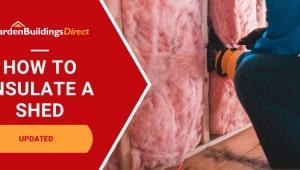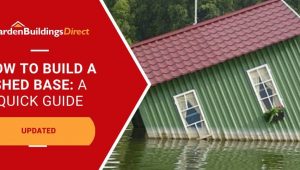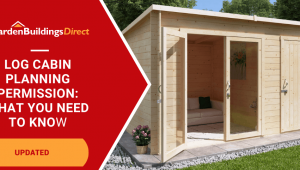Jump to:
As log cabin experts, we’ve seen all the common mistakes when building or installing a log cabin in gardens—all those “that’ll do” moments that didn’t quite work out.
If you’re doing this for the first time, we want to help you get it right. So, our team has compiled a list of these pitfalls, explaining each in detail—why it happens and, of course, how to fix it.
This goes for all types of garden log cabins.
Building Too Close to the Boundary
You can place your log cabin wherever you like in your garden, that’s true. But many owners don’t realise there are boundaries to consider. This means not positioning it too close to the fence or the neighbours. Unfortunately, this is a reoccurring oversight, often made when trying to maximise space.
What happens to the cabin structure when it’s too close to the fence (there should be at least 2 feet) is the material won’t be able to breathe properly. This can lead to condensation, mould build-up, and limited access. It also makes it harder for you to get around the back and sides for maintenance, like applying treatment.
And don’t be tempted to place it right up against your neighbour’s fence (especially if it’s theirs, not yours). On top of the issues above, the last thing you want is any tension or disagreements with them.
The solution: Your log cabin should be at least 2 feet from the boundary, with at least 0.6m to spare (if possible) for easier access. It should also stay under 2.5m in height so it doesn’t block your neighbour’s light.
Rules can vary depending on where you live. We recommend checking with your Local Planning Authority (LPA) for guidance.
Painting the Log Cabin Shed Too Early
This isn’t much of an issue for untreated log cabin sheds, but it is for pressure-treated ones. Since the manufacturer does the treatment and the building arrives pre-treated, many owners feel the urge to paint it straight away. We get it; the greenish tinge isn’t for everyone, which happens as a natural result of the chemical treatment process.
The solution: While you can paint it, the takeaway here is that you must wait. Pressure-treated lumber must dry out, “seasoned,” or “cured,” whatever you call it, before it can be primed or painted. This process takes about 3 to 4 months or longer during winter, up to 6 months, before the moisture levels drop.
Find all the details in our guide: Painting Pressure Treated Wood – How to Do it Right
Choosing the Wrong Location
Many cabin owners overlook key factors like sunlight, drainage, and accessibility. Take a log cabin summer house, for instance.
Some people place it in a shaded corner to keep it cool on hot days, but without enough sunlight, it can become damp, mouldy, and dark inside. Others put it too close to trees for extra shade or privacy, only to face problems like falling debris, root damage, and blocked gutters. Some even position it at the lowest point in the garden to make use of unused space, not realising that water will pool around the base.
The solution: A well-thought-out spot makes all the difference. Choose a location with good drainage, plenty of natural light, and enough space for maintenance access. This is also true if you have an insulated log cabin, even though the structure itself allows for year-round use.
Skipping the Base
Every garden room needs a proper base—unless it comes with a built-in foundation kit. However, many people assume the ground is firm and level enough to support the structure.
Some place it directly on grass or an old patio, thinking it’ll be fine because the cabin feels stable at first. Even worse, they skip a foundation altogether to save time or costs, which leads to structural damage over time.
The solution: Build a base, especially if you’re using your log cabin as a garden gym, where heavy equipment makes a solid, level foundation crucial. It’s the same for a garden bar setup, as extra furniture and appliances add to the weight.
But whatever you plan to use the cabin for, having the right base is always the best approach. Our guide, ‘Does a Garden Room Need a Base?’ answers common questions to help you make an informed choice.
Not Applying a Protective Finish
Some log cabins come pre-treated, so many think they don’t need any further maintenance. Others like the natural timber look and worry that stains or sealants will change its appearance. And let’s be honest, it’s easy to put this off when the cabin seems fine at first.
But pre-treatment is usually just a temporary preservative. Without a proper sealant or paint, the wood is still at risk of moisture damage, UV exposure, and rot. And if the wood is completely untreated, it’ll start weathering even faster.
The solution: Protect your log cabin before it’s too late. If it came pressure-treated, it’s got solid protection against rot, but after about 5-7 years it will start to need some added protection.
For untreated cabins, this is even more important. Apply a good-quality wood preservative first, and then a weatherproof finish to keep it in great shape for years.
Not Allowing the Wood to Move
As an organic material, the timber of your log cabin will not stay in the exact same position you build it in. It will slightly expand and contract with changes in temperature, and some of the parts will shift with gravity.
This only becomes a problem if you start attaching items to the walls and ceiling, because those items will need to be able to move with the wood. It is a common sight to see the logs shift downward, sometimes leaving temporary gaps in between. But if you have nailed cable tubing or picture frames across the boards, you will be putting undue pressure on the timber, which will quickly lead to cracks in the wood as it pulls against the nails.
The best approach is to avoid attaching items directly onto the logs, and certainly not across multiple logs together.
Round-up
If you’re building or installing a garden log cabin, make sure it’s not too close to the boundary. And if it’s newly pressure-treated, wait at least 3 to 6 months before painting it.
Pick a spot with proper drainage, plenty of sunlight, and enough room for maintenance. And don’t forget the base, will you? Once it’s all set, keep it looking good for years with a protective finish.
Now that you know the common mistakes, you can avoid them and the headaches that come with them!
Ready to start your log cabin journey?
This next guide will help if you’re torn between going the DIY route or hiring a professional: Building a Log Cabin – Should I Self Assemble or Hire a Builder?





